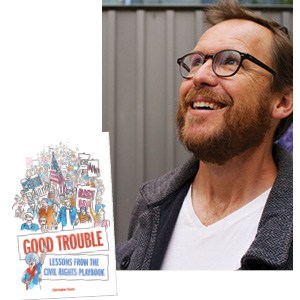Monday, November 4, 6 pm, Sandler Family Campus
On Monday before Election Day, the Hampton Roads community is invited for a FREE triple shot of Vitamin A when activist, author, and artist Christopher Noxon stirs up ‘good trouble’ for civically minded and modern-day activists. In a reception-style talk, and first-ever gallery exhibition of his work, Noxon will share the ‘why’ behind his latest book addressing the civil rights movement in an unconventional journaling style.
“This is an unusual art form,” says Noxon, author of Good Trouble Lessons from the Civil Rights Playbook. “I’m a journalist, not a trained visual artist. This form is intimate like a journal, but it’s not about me. It’s about lessons learned from the civil rights struggle, filtered through my sensibilities. Nothing about the book is political or me trying to convince anyone to do anything. It’s all about embracing change, inspiring hope and human values. I’m not profiting from these lessons. All proceeds go to Center for Popular Democracy. They do the kind of work that was inspired by the Civil Rights movement.”
In preparation for his visit to Hampton Roads, Noxon invested time learning about Virginia’s civil rights history. He spent hours talking to locals such as fellow activists Lois and Barry Einhorn. He learned about Operation Understanding, which was inspired by Lois Einhorn’s meeting with activist Julian Bonds. “This project is sadly defunct,” says Noxon. “But I hope to bring some attention back to it and spark new interest. The St. Paul’s Area Revitalization project is also fascinating to me. It helps to understand where Civil Rights issues are today, and what’s urgent and pressing. Incarceration and housing, not sit-ins and back of the bus.”
Though his book is published, Noxon is still learning. “I didn’t know that the first slave ship arrived on your shores, and the history of America started in Virginia,” says Noxon. “All of this was new to me.” Among other surprises, was the grit and glory of champions like Barbara Johns and Irene Morgan who might have sparked forever heroes like Rosa Parks and Reverend Martin Luther King, Jr. These discoveries resulted in five of the pieces he created for this event.
Noxon’s use of vivid watercolors and intimate text illustrate the importance of joy, faith, and confrontation as an antidote to outrage and despair “I just hope the book’s message comes through and leaves people feeling more hopeful,” says Noxon. “All I need, to fix that state of inertia or hopelessness, is to spend a little time talking to someone who is interested in learning about history, to snap them into a different headspace.”
After spending much time in Alabama, Noxon says he is honored and excited to visit Virginia. “Creating larger pieces for the exhibit was so much fun,” he says. “I’ve never done anything this big. This event gave me my first chance to paint an oak tree.” (the Emancipation Oak Tree at Hampton University.) “This tree was the classroom for newly freed slaves to gather and learn. The first reading of the Emancipation Proclamation took place here.”
Noxon’s painting of Barbara Johns (with Greta Thurnberg, for a modern beat) is also part of the exhibition hanging in the gallery. “One could make a case that without these student strikers, we wouldn’t have Brown V. Board of Education.”
In hindsight, Noxon sees that the ‘men’ with the biggest shoulders were often students and female. “King and legendary male ministers were playing catch up with teenagers and church ladies leading the charge.”
“Whatever you do can be your avenue of protest,” says Noxon. “It can be marching, cooking, stitching, canvassing, organizing carpools or bagging lunches for the homeless. You have to band together. It’s not a solitary activity. If you want to make a change meaningfully, you can’t do it just posting memes on social media.”
Book signing will follow the reception. All book proceeds go to Center for Popular Democracy. Proceeds from the sale of art go to Simon Family JCC’s Arts + Ideas Department and Center for Popular Democracy.
Lisa Richmon

